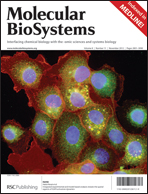CP12, a member of the intrinsically disordered protein family, forms a stable complex with glyceraldehyde-3-phosphate dehydrogenase (GAPDH) and phosphoribulokinase (PRK). To understand the function of conserved residues of CP12 in the formation of the GAPDH–CP12–PRK complex and in the regulation of the enzymes within this complex, we have produced mutants of CP12 by site-directed mutagenesis. The GAPDH, CP12 and PRK recombinant proteins are able to reconstitute spontaneously the ternary complex that has been described in Chlamydomonas reinhardtii. Our analysis reveals that the central part (![[3 with combining low line]](https://www.rsc.org/images/entities/char_0033_0332.gif)
![[5 with combining low line]](https://www.rsc.org/images/entities/char_0035_0332.gif)
![[W with combining low line]](https://www.rsc.org/images/entities/char_0057_0332.gif) XXV
XXV![[E with combining low line]](https://www.rsc.org/images/entities/char_0045_0332.gif)
![[E with combining low line]](https://www.rsc.org/images/entities/char_0045_0332.gif) XXXXXX
XXXXXX![[H with combining low line]](https://www.rsc.org/images/entities/char_0048_0332.gif)
![[4 with combining low line]](https://www.rsc.org/images/entities/char_0034_0332.gif)
![[7 with combining low line]](https://www.rsc.org/images/entities/char_0037_0332.gif) ) of CP12 is required to form the GAPDH–CP12–PRK complex. Using the same series of single amino acid replacements, we have identified individual residues, which seem to represent also contact points for GAPDH. Most notably, substitution of glutamate 74 prevents the binding of GAPDH to CP12. This is similar to the mutant C66S, with which the GAPDH–CP12–PRK complex is not formed. In contrast, replacement of the three last residues (78YED80) of CP12 has no effect on the formation of the ternary supra-molecular complex. However, our findings strongly suggest that Y78 and D80 are involved in the regulation of the GAPDH activity within the supra-molecular complex, since the mutants, D80K and Y78S, do not down-regulate the activity of GAPDH. The replacement of the amino acid E79 weakens the interaction between GAPDH and CP12 as no GAPDH–CP12 sub-complex is formed. In this case, nevertheless, the supra-molecular complex is formed when PRK is present indicating that PRK strengthens the interaction between GAPDH and CP12 within the supra-molecular complex.
) of CP12 is required to form the GAPDH–CP12–PRK complex. Using the same series of single amino acid replacements, we have identified individual residues, which seem to represent also contact points for GAPDH. Most notably, substitution of glutamate 74 prevents the binding of GAPDH to CP12. This is similar to the mutant C66S, with which the GAPDH–CP12–PRK complex is not formed. In contrast, replacement of the three last residues (78YED80) of CP12 has no effect on the formation of the ternary supra-molecular complex. However, our findings strongly suggest that Y78 and D80 are involved in the regulation of the GAPDH activity within the supra-molecular complex, since the mutants, D80K and Y78S, do not down-regulate the activity of GAPDH. The replacement of the amino acid E79 weakens the interaction between GAPDH and CP12 as no GAPDH–CP12 sub-complex is formed. In this case, nevertheless, the supra-molecular complex is formed when PRK is present indicating that PRK strengthens the interaction between GAPDH and CP12 within the supra-molecular complex.

You have access to this article
 Please wait while we load your content...
Something went wrong. Try again?
Please wait while we load your content...
Something went wrong. Try again?
![[3 with combining low line]](https://www.rsc.org/images/entities/char_0033_0332.gif)
![[5 with combining low line]](https://www.rsc.org/images/entities/char_0035_0332.gif)
![[W with combining low line]](https://www.rsc.org/images/entities/char_0057_0332.gif) XXV
XXV![[E with combining low line]](https://www.rsc.org/images/entities/char_0045_0332.gif)
![[E with combining low line]](https://www.rsc.org/images/entities/char_0045_0332.gif) XXXXXX
XXXXXX![[H with combining low line]](https://www.rsc.org/images/entities/char_0048_0332.gif)
![[4 with combining low line]](https://www.rsc.org/images/entities/char_0034_0332.gif)
![[7 with combining low line]](https://www.rsc.org/images/entities/char_0037_0332.gif) ) of CP12 is required to form the GAPDH–CP12–PRK complex. Using the same series of single
) of CP12 is required to form the GAPDH–CP12–PRK complex. Using the same series of single 

 Please wait while we load your content...
Please wait while we load your content...